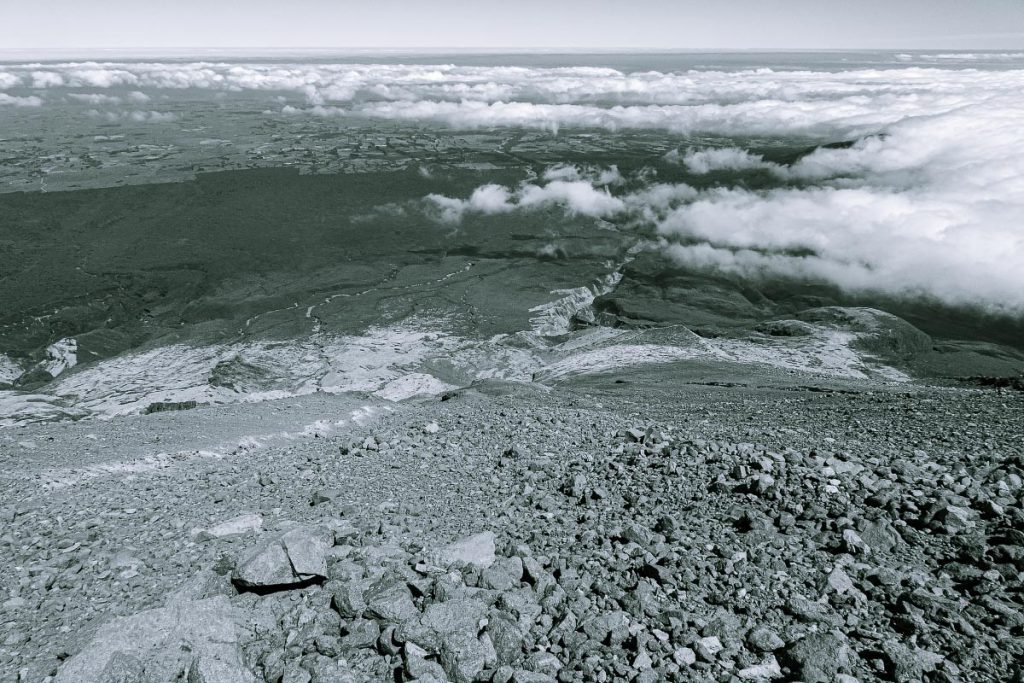Mr Taranaki Maunga
The Maori story of Taranaki’s defeat in a pitched battle with Tongariro over the pretty maiden Pihanga, and his tearful retreat to where he stands today, wounded and lonesome, is well known. But the plate tectonics story of the mountain is less well known and warrants telling too, especially since the mountain is a favourite place to visit for many WTMC trampers, climbers, and yes, even skiers. And perhaps more especially since it is basically an unstable heap of volcanic debris that has collapsed many times in the past, and additionally it is an active volcano that has erupted violently many times in the past.
Taranaki then certainly has had a checkered history. Currently at 2,518 m high it is the tallest and southernmost cone, and only active volcano, in a line of otherwise extinct and increasingly aged and increasingly eroded remnant cones extending northwest including Pouaki, Kaitaki, Paritutu, and Sugar Loaf Island.
The existing active cone is classified as an andesitic stratovolcano. Andesitic because the lava contains an intermediate amount of silica (from rhyolite highest to basalt lowest). This lava causes predominantly explosive activity in an eruption with only small amounts extruded as lava flows—the remainder is erupted as blocks and ash. And ‘strato’ because the cone is built from layers of lava and erupted material.
The problem with stratovolcanoes is that they are inherently unstable and are subject to ‘sector collapse’, much as chunks of a sandcastle fail as it dries. Repeated sector collapses have resulted in the slender pointed conical peak profile of Taranaki.
Note that Ngauruhoe is also a stratovolcano but is geologically very young, about 7,000 years, and is in its initial cone-building phase and so far has not suffered any sector collapses so has a different shaped profile compared to that of Taranaki.
The first recognizable cone at the current location of Taranaki began forming from volcanic eruptions 130,000 years ago (ya). The construction consisted of lava flows for most of the upper cone, and pyroclastic debris (a pyroclastic flow is a dense, fast-moving flow of solidified lava pieces, volcanic ash, and hot gases) and landslide and lahar deposits for the lower slopes—as the mountain is today. Then about 100,000 years ago it collapsed. Another cone began forming but that collapsed about 50,000 ya.


A third peak formed but collapsed towards the southeast 27,000 ya, and then again towards the west 23,000 ya. This latest collapse sent a massive avalanche of volcanic debris 40 km to the western coastline, and covered 250 sq km of ring plain to an average depth of 20 m. The landscape west of Taranaki was covered in ‘mound fields’, small hillocks where large boulders caused a pile-up of smaller stones in the debris. These mounds remain today as a feature of the farmland surrounding the mountain, especially in the Okato to Opunake area. The scar of this collapse is plainly visible on the western side of the mountain, and is particularly obvious looking down from the summit (if you prefer the Maori story then it is the same scar mentioned as one of the wounds suffered by Taranaki in his battle with Tongariro).
The latest eruptions from Taranaki were a series of eight events spread over 300 years, the most recent in 1755. The dome that forms the summit today was the result of the emplacement of a tholoid (a blob of viscous lava extruded from the crater vent) but which was then subsequently mostly demolished by an explosive eruption just below the summit on the west side of the mountain. This breached crater wall is obvious when at the summit, and also when viewing the mountain from the west.
This latest eruption caused numerous faults in the summit rocks, radiating from the summit and extending about 500 m down the slopes. This upper 500 m of the peak is therefore seriously weakened. The next eruption is considered to be likely from the summit crater but will be directed mostly to the west by the breached crater wall.
Some andesitic volcanoes are capable of ‘Plinian’ eruptions—the powerful type of eruption with devastating airborne clouds of hot gas and volcanic ash travelling at high speed typified by Mt Vesuvius and Mt St Helens. And Taranaki is one of them.
The most violent phases of these events are lateral blast eruptions, that are sideways airborne clouds of hot gas and debris that at Taranaki have historically reached a distance of up to 30 km from the crater destroying everything in their path.
Taranaki has now been granted the status of a ‘person’—in a similar way to the Whanganui River before it. Now he will be able to sue (and be sued) just as you and I can. If you are injured in an accident that is not your fault then you can expect compensation for the costs of being returned to good health—now Taranaki can be expected to be compensated and returned to environmental health in the event of any injury. But while this seem reasonable over a short time span, does it really make sense over a longer one?

While in a good mood Mr Taranaki is fun to be with and we enjoy his company while tramping, climbing, skiing, or just relaxing with him as an old and trusted companion. But we should remember that there are those unpredictable times when his underlying vindictiveness comes to the surface and he becomes a raving and violent lunatic bent on wholesale destruction of everything in his reach—and in the process likely also seriously damaging himself. And there is simply no way to reason with such unstable individuals—their proclivity to self-harm and violent destruction is just part of who they are and the inevitable end result of evolutionary processes.
Another temper tantrum from Taranaki sometime soon is a very real possibility given that his mean eruptive period is between 300-330 years and it has been 265 years since his last one. His mean period between sector collapses is 16,000 years and it has been 23,000 years since the last. The consequences of either of these is likely to be catastrophic.
So, perhaps in the meantime we shouldn’t worry too much about damaging Mr. Taranaki with our feeble human activities, because sometime soon he is going to far more seriously damage himself anyway, along with much of that which surrounds him, in yet another one of his violent fits of rage.
While Mr. Taranaki may expect us to be liable for any damage to him, you can bet that when he goes on another of his mindless rampages he will be unlikely to pay up if we sue him for his willful damage to us.

Some really cool stories of Mt Taranaki climbs – thanks WTMC!!
Kendall